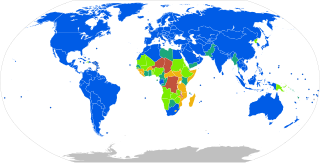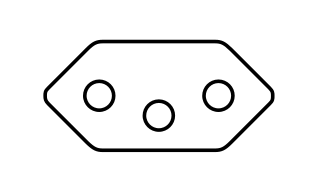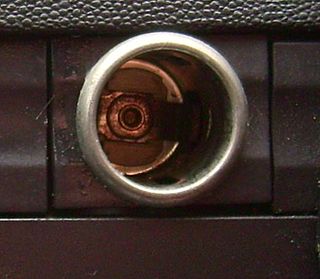
Mains electricity or utility power, grid power, domestic power, and wall power, or, in some parts of Canada, hydro, is a general-purpose alternating-current (AC) electric power supply. It is the form of electrical power that is delivered to homes and businesses through the electrical grid in many parts of the world. People use this electricity to power everyday items by plugging them into a wall outlet.

A power strip is a block of electrical sockets that attaches to the end of a flexible cable, allowing multiple electrical devices to be powered from a single electrical socket. Power strips are often used when many electrical devices are in proximity, such as for audio, video, computer systems, appliances, power tools, and lighting. Power strips often include a circuit breaker to interrupt the electric current in case of an overload or a short circuit. Some power strips provide protection against electrical power surges. Typical housing styles include strip, rack-mount, under-monitor and direct plug-in.

Schuko is a plug/socket system used in much of Europe. It is a registered trademark referring to a system of AC power plugs and sockets that is defined as "CEE 7/3" (sockets) and "CEE 7/4" (plugs). A Schuko plug features two round pins of 4.8 mm diameter for the line and neutral contacts, plus two flat contact areas on the top and bottom side of the plug for protective earth (ground). The socket has a predominantly circular recess which is 17.5 mm deep with two symmetrical round apertures and two earthing clips on the sides of the socket positioned to ensure that the earth is always engaged before live pin contact is made. Schuko plugs and sockets are symmetric AC connectors. They can be mated in two ways, therefore line can be connected to either pin of the appliance plug. As with most types of European sockets, Schuko sockets can accept Europlugs. Schuko plugs are considered a very safe design when used with Schuko sockets, but they can also mate with other sockets to give an unsafe result.

A residual-current device (RCD), residual-current circuit breaker (RCCB) or ground fault circuit interrupter (GFCI) is an electrical safety device that interrupts an electrical circuit when the current passing through a conductor is not equal and opposite in both directions, therefore indicating leakage current to ground or current flowing to another powered conductor. The device's purpose is to reduce the severity of injury caused by an electric shock. This type of circuit interrupter cannot protect a person who touches both circuit conductors at the same time, since it then cannot distinguish normal current from that passing through a person.
A distribution board is a component of an electricity supply system that divides an electrical power feed into subsidiary circuits while providing a protective fuse or circuit breaker for each circuit in a common enclosure. Normally, a main switch, and in recent boards, one or more residual-current devices (RCDs) or residual current breakers with overcurrent protection (RCBOs) are also incorporated.

AC power plugs and sockets connect devices to mains electricity to supply them with electrical power. A plug is the connector attached to an electrically-operated device, often via a cable. A socket is fixed in place, often on the internal walls of buildings, and is connected to an AC electrical circuit. Inserting the plug into the socket allows the device to draw power from this circuit.
Appliance classes specify measures to prevent dangerous contact voltages on unenergized parts, such as the metallic casing, of an electronic device. In the electrical appliance manufacturing industry, the following appliance classes are defined in IEC 61140 and used to differentiate between the protective-earth connection requirements of devices.

IEC 60309 is a series of international standards from the International Electrotechnical Commission (IEC) for "plugs, socket-outlets and couplers for industrial purposes". They are also referred to as "pin & sleeve" connectors in North America or as "CeeForm" connectors in the entertainment industry. The maximum voltage allowed by the standard is 1000 V DC or AC; the maximum current, 800 A; and the maximum frequency, 500 Hz. The ambient temperature range is −25 °C to 40 °C.

Mains electricity by country includes a list of countries and territories, with the plugs, voltages and frequencies they commonly use for providing electrical power to low voltage appliances, equipment, and lighting typically found in homes and offices. Some countries have more than one voltage available. For example, in North America, a unique split-phase system is used to supply to most premises that works by center tapping a 240 volt transformer. This system is able to concurrently provide 240 volts and 120 volts. Consequently, this allows homeowners to wire up both 240 V and 120 V circuits as they wish. Most sockets are connected to 120 V for the use of small appliances and electronic devices, while larger appliances such as dryers, electric ovens, ranges and EV chargers use dedicated 240 V sockets. Different sockets are mandated for different voltage or maximum current levels.
In electricity supply design, a ring circuit is an electrical wiring technique in which sockets and the distribution point are connected in a ring. It is contrasted with the usual radial circuit, in which sockets and the distribution point are connected in a line with the distribution point at one end.
Electrical wiring in the United Kingdom is commonly understood to be an electrical installation for operation by end users within domestic, commercial, industrial, and other buildings, and also in special installations and locations, such as marinas or caravan parks. It does not normally cover the transmission or distribution of electricity to them.

The Europlug is a flat, non-rewirable two-pole, round-pin domestic AC power plug, rated for voltages up to 250 V and currents up to 2.5 A. It is a compromise design intended to connect low-power Class II appliances safely to the many different forms of round-pin domestic power socket used across Europe. However, it is not compatible with the rectangular-pin BS 1363 sockets found in Cyprus, Gibraltar, Singapore, Malaysia, United Arab Emirates, Hong Kong, Ireland, Malta and the United Kingdom. By the standard, Europlugs must be non-rewirable and must be supplied attached to a power cord; anything else is non-compliant.
An earthing system or grounding system (US) connects specific parts of an electric power system with the ground, typically the equipments conductive surface, for safety and functional purposes. The choice of earthing system can affect the safety and electromagnetic compatibility of the installation. Regulations for earthing systems vary among countries, though most follow the recommendations of the International Electrotechnical Commission (IEC). Regulations may identify special cases for earthing in mines, in patient care areas, or in hazardous areas of industrial plants.

IEC 60906-1 is an international standard designed "to provide a standard for a safe, compact and practical 16 A 250 V AC system of plugs and socket-outlets that could be accepted by many countries as their national standard, even if not in the near future." The standard was originally published by the International Electrotechnical Commission in 1986; the current edition is ed2.0 published in 2009. Although it is almost identical to the Swiss SEV 1011 T12 plug for 10 A 250 V a.c. standardised in 1937, its dimensions are slightly different and its polarization is flipped. As of July 2014, only South Africa has introduced a standard based closely on IEC 60906-1. Brazil used it as the basis for its NBR 14136 standard, but this is not compatible with IEC 60906-1. In 2017 the European Union (EU) published recommendations advising against the harmonisation of domestic plug and socket systems in the EU.

AS/NZS 3112 is the harmonised/joint Australian and New Zealand Standard for AC power plugs (male) and sockets (female). The standard is used in Australia, New Zealand, Fiji, Tonga, Solomon Islands, Papua New Guinea and several other Pacific island countries, plus in Argentina and China. The International Electrotechnical Commission (IEC) "world plugs" Web site calls this plug Type I.

In electrical safety testing, portable appliance testing is a process by which electrical appliances are routinely checked for safety, commonly used in the United Kingdom, Ireland, New Zealand and Australia. The formal term for the process is "in-service inspection & testing of electrical equipment". Testing involves a visual inspection of the equipment and verification that power cables are in good condition. Additionally, other tests may be done when required, such as a verification of earthing (grounding) continuity, a test of the soundness of insulation between the current-carrying parts, and a check for any exposed metal that could be touched. The formal limits for a pass/fail of these electrical tests vary somewhat depending on the category of equipment being tested.

An automobile auxiliary power outlet in an automobile was initially designed to power an electrically heated cigarette lighter, but became a de facto standard DC connector to supply electrical power for portable accessories used in or near an automobile directly from the vehicle's electrical system. Such include mobile phone chargers, cooling fans, portable fridges, electric air pumps, and power inverters.

An electric power system is a network of electrical components deployed to supply, transfer, and use electric power. An example of a power system is the electrical grid that provides power to homes and industries within an extended area. The electrical grid can be broadly divided into the generators that supply the power, the transmission system that carries the power from the generating centers to the load centers, and the distribution system that feeds the power to nearby homes and industries.

Plugs and sockets for electrical appliances not hardwired to mains electricity originated in the United Kingdom in the 1870s and were initially two-pin designs. These were usually sold as a mating pair, but gradually de facto and then official standards arose to enable the interchange of compatible devices. British standards have proliferated throughout large parts of the former British Empire.
There are approximately 20 types in common use around the world, such as AC power plugs and sockets, and many obsolete socket types which are still found in older buildings.


















